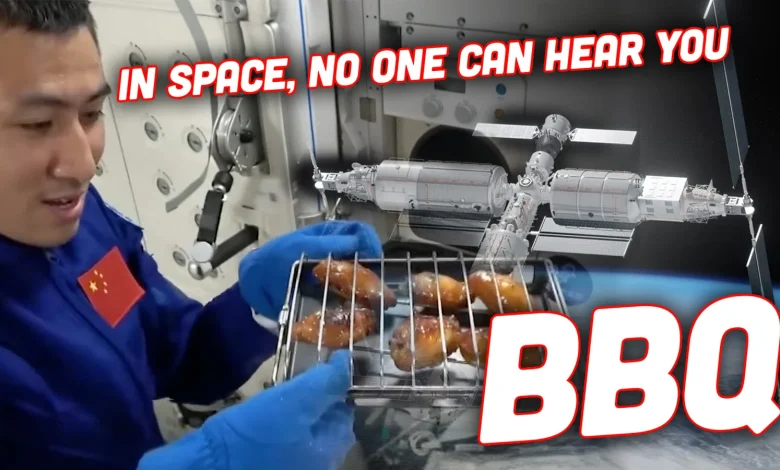Chicken Wings And Steak Are Being Cooked In Orbit In China’s New Space Oven

Have you been considering spending more time in Earth’s orbit, but have been putting it off because of the difficulty of getting piping-hot chicken wings while hurtling around the planet? Sure you have; it’s a valid concern! Well, boy do I have good news for you: in China’s space station, Tiangong, a new hot-air oven was just recently used for the first time, cooking up chicken wings and peppered steak for the six taikonauts currently on the station. The food looked pretty good!
This is actually the second oven that has flown in space; back in 2019, a company called Zero G Kitchen designed and built a Space Oven that was sent to the International Space Station (ISS) aboard a Cygnus cargo ship. Chocolate chip cookies were baked in the oven, one of which is currently on display at the Smithsonian’s Udvar-Hazy Center in Virginia, in case you’d like to see what a space-cookie looks like.
The oven installed in Tiangong seems somewhat similar, though details on the oven itself are somewhat hard to come by. It appears to be a hot-air-type oven, though not a convection oven in the strictest sense, as those tend not to work well in a microgravity environment. The oven is said to be oil-free and has residue collection systems and multi-layer filtration to allow it to function within the station’s pretty strict environmental parameters.
Here’s video of the oven in action, cooking up in 28 minutes (some sources describe it as “grilling” and there is a sort of wire grille used to contain the meat, though I’m not clear if this meets the strict standard of grilling, but maybe?) chicken wings and steak:
This video has some more translations, which is helpful:
I gotta hand it to the crews of Shenzou-20 and -21, those wings and steak bits look pretty damn good! The oven came up with the new three-person crew on Shenzou-21, which is why the station is currently home to six taikonauts; the usual long-term crew for the station is three, but during crew transfer periods, there’s six taikonauts on the station, so that’s the time to have a party and break out the good food.
Screenshots: YouTube, CCT
The food is significantly better looking than most space food, being real, genuine meat, on the bone in the case of the chicken. This is food intended to be eaten soon after docking, and likely is not held to the same storage and preservation standards of other space food that would be stored on the station. Most food served on Tiangong is closer to what most space food looks like, which is to say various pouches of goops and clumps:
Screenshots: YouTube, CCT
That doesn’t mean it doesn’t taste good – I’ve heard a lot of what is eaten on the ISS and other spacecraft is actually quite good – but it doesn’t look as appetizing as real food.
Which is why I think I’m so impressed with this recent orbital cookout; look how good these steak bits look:
Screenshots: YouTube, CCT
Those look great! I wonder if the microgravity environment keeps juices inside the meat more, since there’s no dripping, as such, in the absence of gravity? Hopefully these taikonauts will be writing up full reports on this all.
It’s interesting to see the progress in space food preparation; as astronauts and cosmonauts and taikonauts spend long periods of time working and living in space, food becomes more and more important, not just for health and nutrition reasons but for cultural and psychological reasons. Things have come a long way from the days of the Apollo-era Wet Meats:
Even the old ’60s and ’70s-era Apollo capsules had some attempts to make food more palatable; the capsules had a water injector to re-hydrate foods in packages, though, sadly, the water wasn’t heated:
Later, when America launched their first space station, Skylab, provisions were made for food warmers, so astronauts staying in space for long periods of time (the record on Skylab was 84 days, for example) could eat hot food, and that food was served on a sort of “table” to make eating more like an actual meal as opposed to floating upside down and sucking meat paste out of a bag. The table setup was kind of appealing:
The ISS has used a table for communal meals pretty much since its first crewed expedition in 2000. The astronauts and cosmonauts have been pretty creative with their combination of long-lasting packaged food, canned food, and fresh food, and even put togther things like pizzas when they have the ingredients available:
Image: NASA
I’m happy to see this space culinary development happening aboard the Tiangong, and look forward to more space-cooking advances. Will we see safe, zero-G deep fryers at some point? Woks? Rotisseries? If we’re serious about having a long-term presence in space, the food has to be good.





